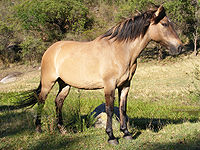
Photo from wikipedia
The genomic sequence of the horse has been available since 2009, providing critical resources for discovering important genomic variants regarding both animal health and population structures. However, to fully understand… Click to show full abstract
The genomic sequence of the horse has been available since 2009, providing critical resources for discovering important genomic variants regarding both animal health and population structures. However, to fully understand the functional implications of these variants, detailed annotation of the horse genome is required. Currently, the horse genome is annotated using limited available RNA-seq data, as well as through comparative genomics by translating human and mouse genome annotation. While this approach has served the equine researchers well and led to various discoveries that would improve care and management of horses, many important questions remain unanswered. The limitation of the current annotation is two pronged. First, the heavy reliance on short-read sequencing-based RNA-seq data meant that alternate isoforms could not be accurately resolved. Second, epigenomic regulatory elements are crucial to detailed understanding of gene expression network but are yet to be systemically identified in the horse. Many of these regulatory elements, including enhancers, promoters, and insulators, are either not transcribed or transcribed at a very low level, necessitating alternate approaches to identify them. To solve above problems, the Functional Annotation of the Animal Genomes (FAANG) project proposed a systemic approach to tissue collection, phenotyping, and data generation, adopting the blueprint laid out by the Encyclopedia of DNA Elements (ENCODE) project. Here we detail the first comprehensive overview of gene expression and regulation in the horse, providing the equine research community an expanded set of genomics resources for studies of complex traits in the horse. Author Summary Functional annotation of a reference genome provides critical information that pertains the tissue-specific gene expression and regulation. Non-model organisms often rely on existing annotations of human and mouse genomes and the conservation between species for their genome annotation. This approach has limited power in annotating transcripts and regulatory elements that are less evolutionarily conserved. Such are the cases of alternatively spliced isoforms and enhancer elements. In a large-scale collaborated effort, Functional Annotation of Animal Genome (FAANG) aims to generate species-specific and tissue-aware functional annotation for farm animals. In this study, we present the overall annotation efforts and findings from the equine FAANG group. This integrated annotation for the horse genome provides, for the first time, a comprehensive overview of gene expression and regulation landscape in nine major equine tissues, as well as an analytical framework for further inclusion of other important tissues.
Journal Title: PLOS Genetics
Year Published: 2022
Link to full text (if available)
Share on Social Media: Sign Up to like & get
recommendations!